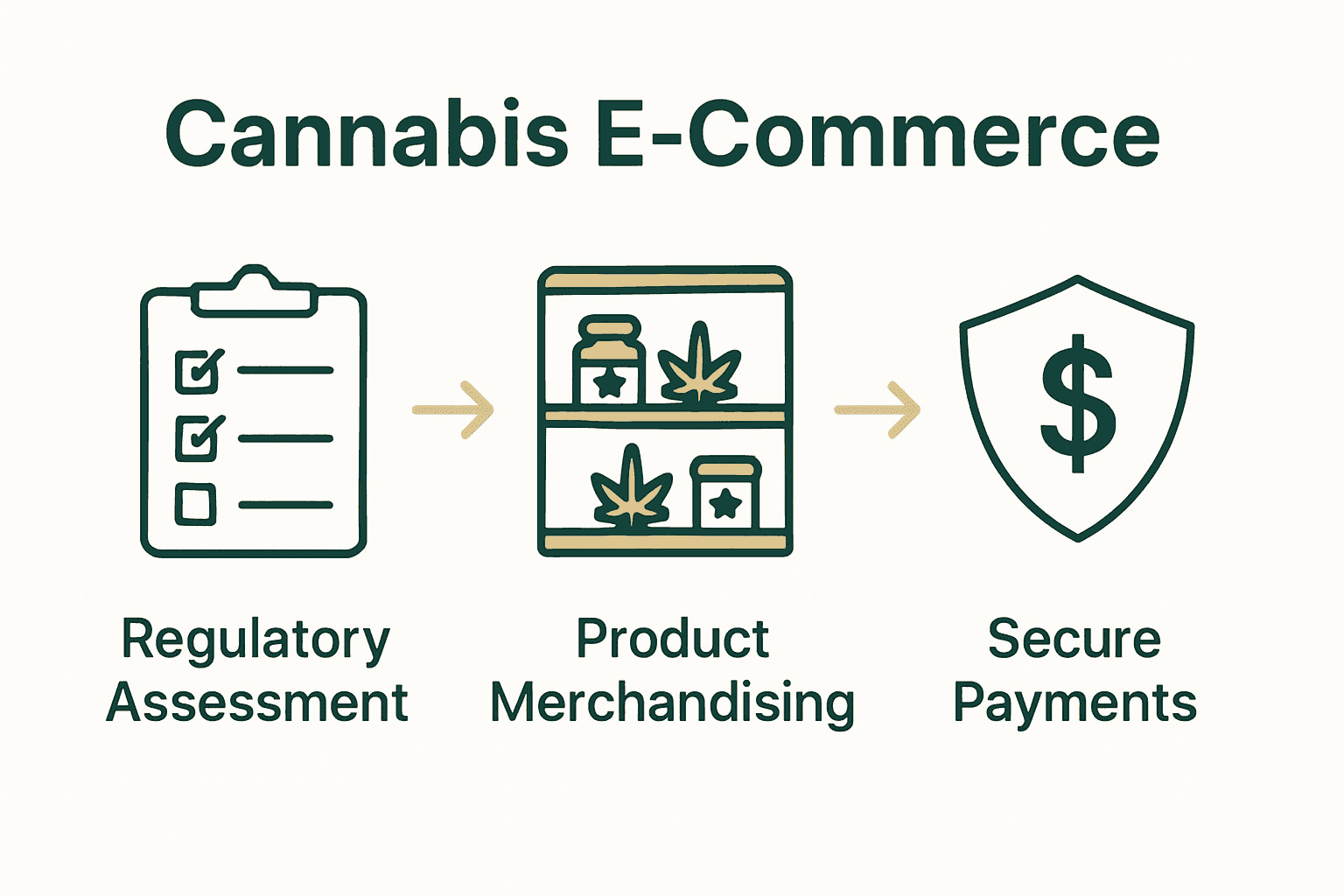Did you know that the legal cannabis market in the U.S. is projected to reach over 40 billion dollars by 2025? With so much at stake, getting your cannabis e-commerce venture off the ground requires much more than just a good idea. Staying compliant with shifting laws and regulations determines whether your business thrives or gets sidelined. Learn what matters most from the start so your operation stays secure and fully compliant.
Quick Summary
| Key Point | Explanation |
|---|---|
| 1. Understand state and federal regulations | Research state licensing and compliance laws thoroughly as cannabis remains illegal at the federal level. |
| 2. Develop a compliant product catalog | Curate offerings based on local regulations, differentiating between hemp and marijuana products. |
| 3. Choose specialized payment processors | Identify payment solutions familiar with cannabis transactions to ensure compliance with banking regulations. |
| 4. Create adaptable marketing strategies | Tailor marketing to comply with varied state regulations while educating consumers about product safety. |
| 5. Monitor compliance and customer experience | Implement performance tracking metrics and quality assurance to foster customer trust and maintain compliance. |
Table of Contents
- Step 1: Assess Legal And Regulatory Requirements
- Step 2: Set Up Product Catalog And Merchandising
- Step 3: Integrate Secure Payment And Shipping Solutions
- Step 4: Launch Digital Marketing And Promotional Campaigns
- Step 5: Monitor Performance And Optimize Customer Experience
Step 1: Assess Legal and Regulatory Requirements
When launching a cannabis e-commerce store, understanding the legal landscape is your first critical step. You need a comprehensive strategy that navigates the complex web of state and federal regulations to protect your business and ensure compliance.
Start by recognizing the fundamental reality of cannabis regulation in the United States. According to Chambers Practice Guide, cannabis remains a Schedule I substance at the federal level while state regulators control licensing and enforcement. This means your compliance strategy must be multilayered and adaptable.
Your first action is to research the specific cannabis regulations in your state. Each state has unique licensing requirements, testing standards, and sales restrictions. Pay close attention to:
Here’s a summary of key compliance areas to monitor when setting up your cannabis e-commerce store:
| Compliance Area | State Regulations | Federal Regulations |
|---|---|---|
| Licensing | Mandatory, varies | Prohibited (Schedule I) |
| Product Testing | State-specific labs | No federal standards |
| Sales Restrictions | Medical/Adult-Use Age limits |
No legal sales allowed |
| Packaging & Labeling | Required, state rules | FDA for hemp-derived only |
| Business Expenses | Permitted | Section 280E applies |
- State licensing procedures for cannabis retailers
- Specific e-commerce sales restrictions
- Product testing and quality control mandates
- Age verification protocols
- Packaging and labeling requirements
As Reuters Legal Insights highlights, testing regulations vary widely across states. This inconsistency means you must be meticulous in understanding and meeting local standards to avoid potential legal exposure.
Pro Tip: Consult with a cannabis law specialist who understands both state and federal regulatory frameworks to develop a robust compliance strategy.
Remember that navigating Internal Revenue Code Section 280E will impact your financial planning. This regulation prevents cannabis businesses from deducting ordinary business expenses, which will significantly influence your accounting and tax strategy.
In our next step, you will dive deeper into selecting the right business structure and obtaining the necessary permits to legally operate your cannabis e-commerce platform.
Step 2: Set Up Product Catalog and Merchandising
Building a strategic and legally compliant product catalog is your next crucial step in launching a successful cannabis e-commerce platform. You will need to carefully curate your offerings while navigating complex regulatory requirements.
According to Chambers Practice Guide, the FDA maintains strict oversight of hemp-derived products. This means you must meticulously differentiate between hemp and marijuana products in your catalog, ensuring each item meets precise testing, labeling, and marketing standards.
Start by understanding the legal landscape of your target markets. Wikipedia research reveals that cannabis legalization varies dramatically across states. As of late 2023, 24 states allow non-medical cannabis while others restrict sales to medical use only. Your product catalog must be dynamically tailored to each state regulatory environment.
When developing your catalog, focus on these key elements:
- Clear product categorization (hemp-derived vs marijuana-based)
- Precise THC and cannabinoid content labeling
- Age verification mechanisms
- Detailed product descriptions with legal compliance information
- High-quality product imagery
- Transparent sourcing and testing documentation
Pro Tip: Implement geolocation technology to automatically filter product availability based on the user’s state legal restrictions.
Each product should come with comprehensive information about its legal status, potential effects, recommended usage, and compliance certifications. This transparency builds customer trust and demonstrates your commitment to responsible cannabis retailing.

In the next step, you will explore setting up secure payment processing and exploring financial infrastructure for your cannabis e-commerce platform.
Step 3: Integrate Secure Payment and Shipping Solutions
Navigating payment and shipping solutions for your cannabis e-commerce platform requires strategic planning and specialized financial technologies. You will need to develop a robust infrastructure that addresses the unique challenges of the cannabis industry.
Payment processing remains one of the most complex aspects of cannabis e-commerce. As Wikipedia details about Hypur, specialized financial solutions have emerged to support regulated industries like cannabis. These platforms enable secure transaction monitoring and provide alternatives to traditional cash-based systems.
Your primary focus should be identifying payment processors experienced in handling cannabis transactions.
 Look for partners who understand the nuanced regulatory landscape and can provide transparent financial services. Some key considerations include:
Look for partners who understand the nuanced regulatory landscape and can provide transparent financial services. Some key considerations include:
- Compliance with state and federal banking regulations
- Robust age verification systems
- Secure transaction tracking
- Ability to handle interstate commerce restrictions
- Transparent fee structures
The potential passage of the SAFE Banking Act could significantly transform payment infrastructure for cannabis retailers. This proposed legislation aims to protect financial institutions serving cannabis businesses and lower existing banking risks.
Pro Tip: Maintain multiple payment alternative options to provide customers flexibility and backup methods in case one processing channel experiences temporary restrictions.
For shipping solutions, partner with carriers experienced in age-restricted and regulated product deliveries. Implement strict verification protocols to ensure packages are only delivered to legally authorized recipients.
In the next step, you will explore developing a comprehensive marketing strategy that complies with complex advertising regulations in the cannabis industry.
Step 4: Launch Digital Marketing and Promotional Campaigns
Digital marketing for cannabis e-commerce requires a strategic approach that balances creativity with strict regulatory compliance. You will need to develop nuanced marketing campaigns that reach your target audience while navigating complex advertising restrictions.
According to Cannabis Business Times, cannabis advertising remains highly fragmented across states and digital platforms. This means your marketing strategy must be adaptable and carefully constructed to meet diverse regulatory requirements.
Understand the limitations of major digital platforms. As Cannaspire reports, Meta platforms like Facebook and Instagram prohibit most THC product advertisements. This restriction requires you to get creative with your marketing approach.
Your digital marketing strategy should focus on:
- Geo-targeted content specific to legal markets
- Robust age verification mechanisms
- Educational content about cannabis products
- Compliance-focused messaging
- Building community through responsible engagement
Leverage emerging marketing channels that offer more flexibility. Connected TV programmatic advertising and specialized cannabis marketing platforms can help you reach adult audiences while maintaining legal compliance.
Pro Tip: Create content that educates and informs rather than directly promoting specific products to maximize your marketing reach.
Embrace content marketing strategies that provide value to your audience. Develop blog posts, educational videos, and informative guides that demonstrate your expertise without making direct product claims that might violate advertising restrictions.
In the next step, you will explore building customer trust through transparent communication and exceptional customer support strategies.
Step 5: Monitor Performance and Optimize Customer Experience
Continuous performance monitoring and customer experience optimization are critical for sustaining your cannabis e-commerce platform’s success. You will need to develop a comprehensive approach that balances data analysis with responsive customer service strategies.
As Reuters Legal Insights emphasizes, inconsistent testing standards pose significant risks throughout the product lifecycle. This means your performance monitoring must go beyond traditional metrics to include rigorous quality assurance and standardized testing protocols.
Implement a multifaceted performance tracking system that captures key indicators:
- Customer satisfaction ratings
- Product return and exchange rates
- Conversion funnel analytics
- Customer support response times
- Compliance and regulatory adherence metrics
Utilize advanced analytics tools that provide real-time insights into customer behavior and platform performance. These tools will help you identify potential issues before they become significant problems and allow you to make data-driven improvements to your e-commerce experience.
Pro Tip: Develop an automated feedback loop that immediately flags potential product quality or regulatory compliance concerns.
Create a customer support framework that prioritizes transparency and rapid resolution. Train your support team to handle complex inquiries related to product information, legal restrictions, and customer concerns with empathy and expertise.
In the final step, you will learn how to scale your cannabis e-commerce platform while maintaining the highest standards of quality and compliance.
Transform Compliance and Wellness Into Growth With 23State
If launching a compliant cannabis e-commerce store feels overwhelming, you are not alone. Many new entrepreneurs struggle to build a secure product catalog, meet shifting regulations, and stand out in a crowded industry. Your article details the tough realities of legal compliance, secure payment integration, and customer experience. What if you could focus on growth and customer satisfaction while leaving product quality and regulatory peace of mind to an expert partner?
Explore our CBD collection for legally compliant, carefully tested hemp products ready to enrich your new store’s catalog and please wellness-focused shoppers.

Now is the time to streamline compliance and unlock new revenue for your business. Visit 23State.com for premium cannabis products and advanced merchandising solutions, or browse our CBN options to diversify your offerings. Give your store the edge it deserves—secure your next step toward a thriving cannabis retail platform today.
Frequently Asked Questions
What are the key legal requirements for launching a cannabis e-commerce store?
To launch a cannabis e-commerce store, you need to understand state and federal regulations, including licensing, product testing, and sales restrictions. Start by thoroughly researching your state’s specific cannabis regulations to ensure compliance and avoid legal pitfalls.
How do I effectively set up my product catalog for a cannabis e-commerce store?
To set up your product catalog, clearly categorize products (e.g., hemp-derived vs. marijuana) and provide detailed descriptions that include legal compliance information. Prioritize clear THC labeling and sourcing documentation to build transparency with your customers.
What payment processing solutions should I consider for my cannabis e-commerce platform?
You should seek payment processors that specialize in cannabis transactions and comply with both state and federal banking regulations. Evaluate options based on their compliance capabilities, age verification systems, and secure transaction tracking features within 30 days of starting your search.
How can I create a compliant digital marketing strategy for cannabis products?
Develop a digital marketing strategy that includes geo-targeted content and robust age verification mechanisms while focusing on educational rather than promotional content. Utilize emerging marketing channels to improve visibility, aiming for a strategy launch within 60 days.
What metrics should I monitor to optimize customer experience on my cannabis e-commerce site?
Key metrics to monitor include customer satisfaction ratings, conversion rates, and compliance adherence. Implement a performance tracking system and aim to analyze these metrics monthly to adjust your strategy and enhance the user experience.
How can I ensure ongoing compliance with cannabis regulations in my e-commerce operations?
To ensure ongoing compliance, regularly review your operational practices against current regulations and update your processes as needed. Conduct compliance audits at least quarterly to identify and address any issues proactively.

